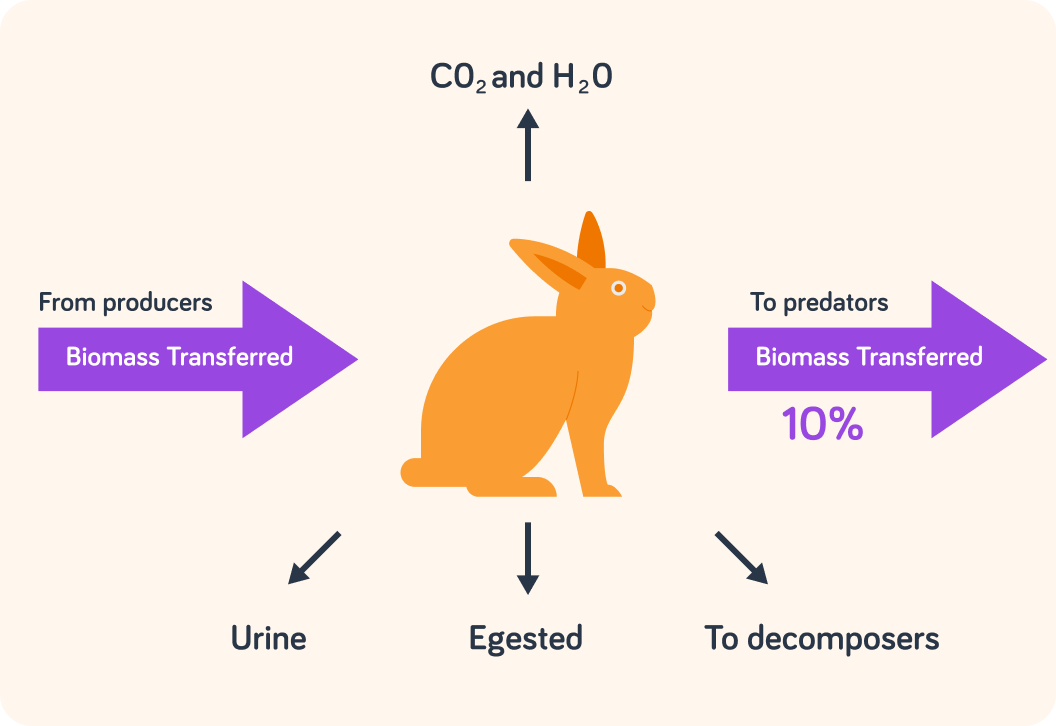YOU ARE LEARNING:
Transfer of Biomass

Transfer of Biomass
The energy consumed by an organism does not all go into the predator in the next trophic level - some of it is lost. Losses of biomass occur for several reasons, which will be discussed.
Plants or algae form the producer trophic level in most food chains. They are able to produce new biomass by using which process?

Photosynthesis allows plants to capture energy from light and store it as chemical energy in the form of glucose. What percentage of the light energy that falls on a leaf do you think might end up as energy captured in glucose?

Although it seems like very little that only 1% of light energy that falls on a leaf actually makes it into the glucose, it is more than enough to provide the biomass and the energy to support a whole ecosystem.
A producer can make new biomass by combining the glucose with inorganic compounds from their surroundings, like nitrates. These are used to build the plant's or the algae's bodies. What types of organic compounds are their bodies typically made of? Pick all the options you think are correct.

You can select multiple answers
Rabbits eat grass, and foxes eat rabbits. What percentage of the biomass do you think is passed on to the next trophic level in a food chain, for example between the grass and the rabbits or between the rabbits and the foxes?

On average only 10% **** or 101 of the biomass from one trophic level is passed on to become the biomass of the next trophic level. So for each 1000 grams grass, you can have 100 grams rabbit and 10 grams fox.
Oak tree leaves→Aphids→Ladybirds→Blue tits. We measure the dry biomass of oak tree leaves to 15Kg. What is the probable dry biomass of the blue tit population in this ecosystem in grams?

An average blue tit has a dry biomass of around 5−7g . On average how many blue tits can one oak tree provide enough food for?

A 400m2 field of grass contains around 40000g of grass biomass. This results in only 400g of fox biomass.
The diagram shows the main causes of loss in the rabbit trophic level between the grass and the foxes.

The biomass is transferred from the producers, in this example the grass. But not all the grass eaten will be absorbed into the body of the rabbits. What does the label on the arrow say, that shows that not all that the grass that is eaten will be digested?


Not all of the food eaten by any animal will be digested.
Some of it will pass out of the body as faeces (poo). This biomass is not available to the next level in the food chain. It passes instead to the decomposers in the ecosystem.

To which group of organisms in the ecosystem is urine passed on?
A) The next levels of consumers B) The producers C) The decomposers


One source of loss is shown as CO2 + H2O. From which process are these two compounds produced?


Respiration uses the biomass of the glucose in food to produce the energy for life (ATP). This is a significant cause of biomass loss. This is especially true of warm-blooded organisms that use this energy to maintain their body temperature.
Biomass is passed on to the decomposers via urination and egestion, but there is also another way that biomass passes to the decomposers. Which one?
A) Death and decay. B) Decomposers being consumed by another species.


Of all the biomass that existed in the producers in this food chain, what percentage end up as biomass in the apex carnivores in this example Grass→Rabbit→Fox?


